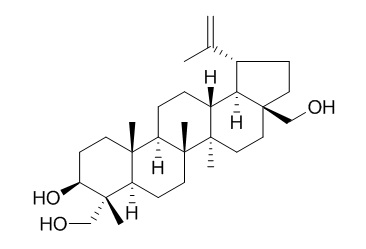23-Hydroxybetulin
23-Hydroxybetulin is a natural product from Betula alba L.
Inquire / Order:
manager@chemfaces.com
Technical Inquiries:
service@chemfaces.com
Tel:
+86-27-84237783
Fax:
+86-27-84254680
Address:
1 Building, No. 83, CheCheng Rd., Wuhan Economic and Technological Development Zone, Wuhan, Hubei 430056, PRC
Providing storage is as stated on the product vial and the vial is kept tightly sealed, the product can be stored for up to
24 months(2-8C).
Wherever possible, you should prepare and use solutions on the same day. However, if you need to make up stock solutions in advance, we recommend that you store the solution as aliquots in tightly sealed vials at -20C. Generally, these will be useable for up to two weeks. Before use, and prior to opening the vial we recommend that you allow your product to equilibrate to room temperature for at least 1 hour.
Need more advice on solubility, usage and handling? Please email to: service@chemfaces.com
The packaging of the product may have turned upside down during transportation, resulting in the natural compounds adhering to the neck or cap of the vial. take the vial out of its packaging and gently shake to let the compounds fall to the bottom of the vial. for liquid products, centrifuge at 200-500 RPM to gather the liquid at the bottom of the vial. try to avoid loss or contamination during handling.
Front Plant Sci.2020, 11:630.
Molecules.2020, 25(11):2599.
Molecules.2016, 21(6)
Biomed Pharmacother.2024, 174:116598.
Molecules.2019, 24(19):E3417
J Microbiol Biotechnol.2023, 33(10):1317-1328.
Pharmaceutics.2021, 13(11):1839.
International Food Research Journal2018, 25(6):2560-2571
Cosmetics2021, 8(3),91.
Bioorg Chem.2024, 145:107184.
Related and Featured Products
Planta Med. 2016 Sep;82(14):1302-7.
An HPLC-ELSD Method for the Determination of Triterpenes in Sorbus decora and Sorbus americana Bark Used by the Eeyou Istchee Cree First Nation.[Pubmed:
27163231]
METHODS AND RESULTS:
The extraction method reproducibly recovered the compounds above 70 % and the chromatographic separation of betulin, 23-Hydroxybetulin, 23,28-dihydroxylupan-20(29)-ene-3β-caffeate, betulinic acid, α-amyrin, uvaol, 3β,23,28-trihydroxy-12-ursene, and 23,28-dihydroxyursan-12-ene-3β-caffeate was achieved within 27 min by linear gradient. The method produced highly reproducible quantitative data at interday and intraday levels. The limits of detection were in the ng level on-column with remarkable range and linearity. The target compounds were present at mg levels in the populations, collected from inland (Mistissini and Nemaska) and costal (Waskagnish and Chisasibi) Cree communities of northern Quebec. A triterpene, 23-Hydroxybetulin, was the most abundant, while betulinic acid and uvaol were minor constituents.
CONCLUSIONS:
Overall, HPLC-ELSD analyses produced very similar profiles and contents of the eight compounds in the plants collected from four geographic locations. The developed HPLC-ELSD method can be used as a targeted analysis of triterpenes in these medicinal plants.



